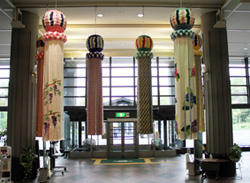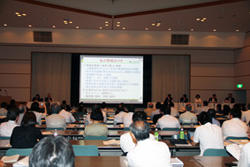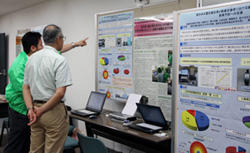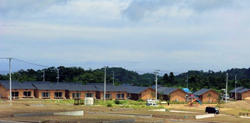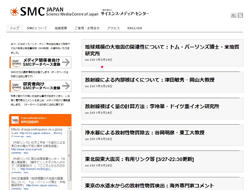Various of the projects that are underway at RISTEX have begun responses to the Great East Japan Earthquake and support activities to resolve problems of disaster victims and areas.
Many lives saved by ongoing tsunami safety and education activities conducted from before the disaster
Working in the Safety and Security R&D Focus Area, Professor Toshitaka Katada of Gunma University Graduate School developed a Comprehensive Tsunami Disaster Scenario Simulator. In the Implementation-Support Program, he has been engaged in consciousness raising activities for residents and disaster preparedness education for elementary and junior high school students over many years.
Kamaishi City in Iwate Prefecture was hit by a tsunami far exceeding the expected scale. The buildings at elementary and junior high schools within one kilometer of the ocean were inundated up to the third floor. Due to the disaster preparedness education and training, however, the lower high school students were able to act calmly and lead the elementary school students in evacuation, and all the students evacuated the schools safely.
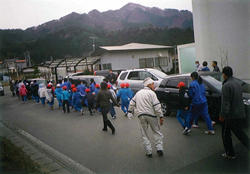
Actual evacuation by elementary and lower secondary school students in Kamaishi City (photo courtesy of Professor Katada)
Improving the Quality of Life of Evacuees at Temporary Housing in Fukushima Prefecture
Evacuees have begun moving into temporary housing in various locations.
In Fukushima prefecture, an area designated for implementation of this activity, evacuation may possibly continue for more than two years because of the impact of the nuclear power plant accident. Therefore, even though this is "temporary" housing, living environment and quality of life are important issues.
Professor Tanba, the Project Director, is aiming to improve evacuees' living environment and quality of life by utilizing his experiences and knowledge gained while contributing to "community maintenance and restoration" in support activities for the former village of Yamakoshi, after the Niigata Chuestsu Earthquake occurred.
Of the 14,000 temporary houses being built by Fukushima prefecture, those targeted for implementation comprise 4,000 temporary houses being built by Fukushima businesses. As can be seen in the photos, many of these temporary houses are built using local Fukushima timber and with noise control measures and facilities such as clinics, assembly places and welfare activity facilities, community buses and so on, an effort has been made to create a living environment that is comfortable as much as is possible for the evacuees. Also in areas of high snowfall, results of research helpful in regard to accumulated snow and prevention of condensation will be implemented.
For services, a consultant will be posted to carry out services such as support to prevent the death of evacuees without anybody present, and also activities to promote health and fitness as well as the maintenance of communities by utilizing the assembly places. Also care will be taken to maintain a support system for children, the elderly, the disabled and so on, who are particularly needy of such support.
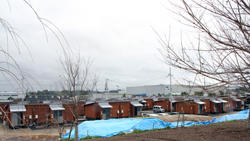
Temporary housing in Motomiya City
Cleaning up Ofunato Bay in Iwate Prefecture and supporting rehabilitation of the fisheries
Ofunato Bay in Iwate Prefecture, an area targeted for implementation, suffered major damage from the tsunami. As well as fishing boats, aquaculture facilities, processing factories and so on were more or less completely destroyed. The fisheries will take a long time to recover and some of those in the industry may have lost the will to rehabilitate their business and opting instead to simply close down.
This implementation activity makes use of the characteristics of microbubbles and tackles the clean up of the Ofunato Bay and the rehabilitation of the aquaculture industry.
Microbubbles are different to normal bubbles, being very small bubbles about one-quarter the size of a strand of hair. Floating slowly in the water like smoke, air in the microbubbles dissolves and vanishes, causing not only an increase in the amount of oxygen in the water but also it has the characteristic of encouraging the activity of marine life.
In August 2011, 104 large-scale apparatuses capable of generating 288㎡ of microbubbles every day began operation in Akasaki, Ofunato City. By providing a large amount of microbubbles into the ocean, as well as improving the water quality of the whole of Ofunato Bay and improving the marine environment, it is aimed to promote the natural growth of rock oysters, scallops, seaweed and so on. We expect this will be of some help towards recovery and give hope to those in Ofunato fisheries with the comeback of Ofunato's famous local products such as oysters, wakame seaweed and sea urchins.
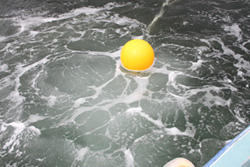
Microbubbles generated five meters under the surface take 30 hours to gradually float to the surface.
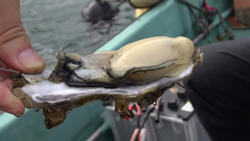
Cultured Rock oysters in November 2011
Science Media Centre of Japan disseminates scientifically reliable information to the mass media and the public
The Science Media Centre of Japan (SMCJ) is an organization established by a project in the Science Technology and Humanity R&D Focus Area. Its purpose is to convey scientific information that is more accurate and multifaceted in order to improve the quality of information circulating among the mass media. (Project Director: Professor Shiro Segawa, Faculty of Political Science and Economics, Waseda University)
In connection with the recent major earthquake, the SMCJ disseminated a variety of scientific information about earthquakes from its website. When public apprehension was increasing about the influence of radioactive contamination, radioactive materials, exposure to radiation, and so on due to the Fukushima Daiichi Nuclear Power Plant accident, the SMCJ continued to convey updated scientifically trustworthy information with help of various area experts. These efforts were very highly acclaimed by the mass media and by the public at large.
Training local government personnel in methods of surveying housing to certify disaster damage
Once an earthquake occurs, it is very important for restoration of victims' livelihoods that local governments promptly survey damage to buildings and issue disaster certificates. Under great confusion after an earthquake, however, damage certification surveys not only involve employees who have knowledge of architecture and financial matters, but may also one who have no expertise in the field at all.
The Project Director of the Implementation-Support Program, Satoshi Tanaka (Professor, Graduate School of Environment and Disaster Research, Fuji Tokoha University), developed a package of local government support operations so that employees who do not have knowledge would be able to perform building damage certification survey. Following the recent earthquake, training in damage certification methods is transferred to local government employees in Kamaishi City and Rikuzentakata City in Iwate Prefecture and other such locations.Once an earthquake occurs, it is very important for restoration of victims' livelihoods that local governments promptly survey damage to buildings and issue disaster certificates. Under great confusion after an earthquake, however, damage certification surveys not only involve employees who have knowledge of architecture and financial matters, but may also one who have no expertise in the field at all.
The Project Director of the Implementation-Support Program, Satoshi Tanaka (Professor, Graduate School of Environment and Disaster Research, Fuji Tokoha University), developed a package of local government support operations so that employees who do not have knowledge would be able to perform building damage certification survey. Following the recent earthquake, training in damage certification methods is transferred to local government employees in Kamaishi City and Rikuzentakata City in Iwate Prefecture and other such locations.
Biotreatment activities following recovery of heavy oil discharged into the ocean
The tsunami at Kesennuma City, Miyagi Prefecture, damaged oil tanks and sank fishing boats, spilled oil into the ocean. The Project Director of the Implementation-Support Program, Kimito Kotani (Chief Researcher, Oita Industrial Research Institute), developed a method of treating spilled oil. Previously such oil had to be incinerated. This method, however, uses an organic fertilizer called "Bark Compost" for decomposition and bio-treatment. This technology costs lower and impacts lower environmentally than the conventional method. This technology is now transferred to waste treatment contractors in Ofunato Bay, Kesennuma Bay, and other such locations affected by the disaster.
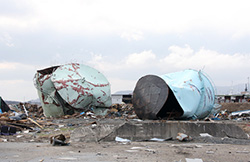
Oil storage tank destroyed by the tsunami
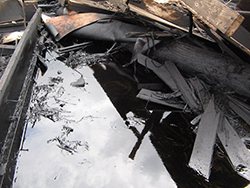
The most viscous fuel oil C was confirmed to have been discharged at Ofunato Bay, and recovery of the oil is presently underway.
Toward the Creation of a Resilient and Sustainable Community
~Symposium to consider earthquake reconstruction and the role of science and technology for society was held in Sendai~
On August 4, 2011 in Sendai, RISTEX held a symposium titled "Reconstruction from the Earthquake as a Contribution to the Creation of Active Local Regions and Communities: Science and Technology for Society brings out the Latent Strength in Local Communities".
Approximately 150 symposium participants engaged in enthusiastic discussion and presented the question of what roles are required of science and technology for society in order to create robust and sustainable local communities for reconstruction.
After Mayor of Sendai, Emiko Okuyama's opening and remarks from Prof. Haruo Hayashi of Kyoto Univ. and Prof. Junko Nagata of Osaka City Univ., the morning session reported on the progress of the RISTEX Great East Japan Earthquake Response and Emergency Research and Development Results Implementation Support Program. The program initiated a total of six projects from May on, and residents of the implementation areas place high hopes on these projects. The symposium also included activity demonstrations and panel displays, and many people were asking the presenters earnest questions.
The day-long sessions were capped by a panel discussion that included discussants involved in formulating reconstruction visions for the three affected prefectures, Hiroshi Suzuki (Chairman of the Fukushima Prefecture Reconstruction Vision Study Committee), Masahiro Ueda (a member of the Iwate Prefecture Committee for Reconstruction from the Great East Japan Earthquake and Tsunami), and Mikiko Ishikawa (Chair of the Iwanuma City Reconstruction Council in Miyagi Prefecture), together with Masayuki Horio (RISTEX Area Director) and Kimiro Meguro (Professor, Institute of Industrial Science, The University of Tokyo). RISTEX Director-General Tateo Arimoto served as a moderator. The discussion ranged over such matters as the importance of giving reconstruction plans visible form and putting them timely into concrete action, the importance of regenerating communities and regions and generating them anew, the problem of disparities between local communities that are occurring hidden in the shadows of the shift to large-scale fishery and agriculture industries, the effectiveness of approaches that combine technology and institutions in both hardware and software aspects, the necessity for remaking this modern era to include consideration of the use of renewable energy as occasioned by the recent earthquake. The discussions, carried on from a variety of different perspectives and experiences, proved to be highly instructive and fruitful.
